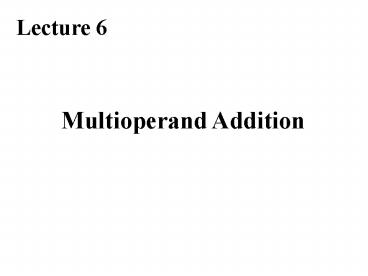Multioperand Addition - PowerPoint PPT Presentation
1 / 36
Title:
Multioperand Addition
Description:
Lecture 6 Multioperand Addition w w w w w w CSA CSA CSA CPA y=a+b+c+d+e mod 2w a b c d e w w w w w w PC CSA CPA y=a+b+c+d+e mod 2w a b c d e s2 s1 s0 Carry Save Adder ... – PowerPoint PPT presentation
Number of Views:183
Avg rating:3.0/5.0
Title: Multioperand Addition
1
Lecture 6
Multioperand Addition
2
Required Reading
Behrooz Parhami, Computer Arithmetic Algorithms
and Hardware Design
Chapter 8, Multioperand Addition Note errata
at http//www.ece.ucsb.edu/parhami/text_comp_ari
t_1ed.htmerrors
3
Recommended Reading
J-P. Deschamps, G. Bioul, G. Sutter, Synthesis
of Arithmetic Circuits FPGA, ASIC and Embedded
Systems
Chapter 11.1.12 Multioperand Adders
4
Applications of multioperand addition
Inner product
Multiplication
n-1
n-1
s ? x(i) y(i) ?
pax
p(i)
i0
i0
5
Number of bits of the result
n-1
S ? x(i)
x(i) ?0..2k-1
i0
Smax n (2k-1)
Smin 0
6
Serial implementation of multioperand addition
7
Adding 7 numbers in the binary tree of adders
8
Ripple-carry adders at levels i and i1
9
Example Adding 8 3-bit numbers
10
Ripple-Carry Carry Propagate Adder (CPA)
a2
b2
a1
b1
a0
b0
an-1
bn-1
c0
c3
c2
c1
cn
cn-1
. . .
FA
FA
FA
FA
s2
s1
s0
sn-1
11
Carry Save Adder (CSA)
c0
c1
c2
cn-1
b0
b1
b2
bn-1
a0
a1
a2
an-1
. . .
FA
FA
FA
FA
c2
c3
s2
s1
c1
s0
s3
sn-1
cn
cn-1
12
A Ripple-Carry vs. Carry-Save Adder
13
Operation of a Carry Save Adder (CSA)
Example
20
24
23
22
21
x y z
0 1 0 1 0 1 1 0 1 1 1 0 1 1 1
s c
0 0 1 1 0 1 1 0 1 1
xyz s c
14
Carry propagate and carry-save adders in dot
notation
15
Specifying full- and half-adder blocks in dot
notation
16
Carry-save adder for four operands
17
Carry-save adder for four operands
s0
s3
s2
s1
c2
c1
c3
c4
s0
s1
s2
s3
c1
c2
c3
c4
18
Carry-save adder for four operands
y
z
w
x
4
4
4
4
CSA
s
c
CSA
s
c
CPA
S
19
Carry-save adder for six operands
Implementation of one-bit slice
CSA tree
20
Tree of carry save adders reducing seven numbers
to two
21
Addition of seven six-bit numbers in dot notation
22
Adding seven k-bit numbers block diagram
23
Relationship Between Number of Inputs and Tree
Height
24
Parameters of tree carry-save adders (1)
Latency
LatencyCSA h(n) ? TFA LatencyCPA(k,
n)
Tree height for n operands
Widths
Component Adders
typically close to k bits
k .. k log2 n
CSA
? k log2 n
CPA
25
Parameters of tree carry-save adders (2)
Maximum number of inputs that can be reduced to
two by an h-level tree, n(h)
n(0) 2
n(h) n(h-1)
n(1) 3 n(2) 4 n(3) 6
n(4) 9 n(5) 13 n(6) 19
2 ( )h-1 lt n(h) ? 2 ( )h
26
Parameters of tree carry-save adders (3)
Smallest height of the tree carry save adder for
n operands, h(n)
h(n) 1 h( )
2
n
3
h(2) 0
h(n) ? log ( )
n
3
2
2
27
(No Transcript)
28
Wallace vs. Dadda Trees (1)
Wallace trees
- Reduce the size of the final Carry Propagate
Adder (CPA) - Optimum from the point of view of speed
Dadda trees
- Reduce the cost of the carry save tree
- Optimum (among the CSA trees) from the point of
- view of area
29
Wallace vs. Dadda Trees (2)
- Wallace reduces number of operands at earliest
opportunity - Goal of this is to have smallest number of bits
for CPA adder - However, sometimes having a few bits longer CPA
adder does not affect the propagation delay
significantly (i.e. carry-lookahead) - Dadda seeks to reduce the number of FA and HA
units - May be at the cost of a slightly larger final CPA
30
Wallace Tree
31
Dadda Tree
32
5-to-3 Parallel Counter
23
22
21
20
24
a b c d e
0 1 0 1 0 1 1 0 1 1 1 0 1 1 1 1 0 1 1 1 1 1 1 1 1
s0 s1 s2
0 1 1 1 0 0 1 1 0 0 1 0 0 1 1
abcde s0s1s2
33
Implementation of 1-bit of 5-to-3 parallel
counter using single CLB slice of a Virtex FPGA
34
Carry Save Adder vs. 5-to-3 Parallel Counter
a
b
c
d
e
w
w
w
w
w
CSA
CSA
CSA
CPA
w
yabcde mod 2w
35
Generalized Parallel Counters
Multicolumn reduction
(5, 5 4)-counter
Generalized parallel counter Parallel
compressor
(2, 3 3)-counter
36
(No Transcript)































